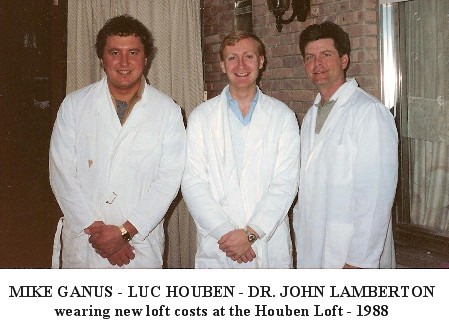
BLOG - December 2008
Although today is December 1, the weather looks best to couple the breeders tomorrow and Wednesday. The high temperature on Tuesday is forecasted at 65 degrees and sunny to partly sunny. It looks like a perfect day to couple breeders. Because the breeding pairs are primarily determined over the past four to six weeks and because many of the breeding pairs were pre-mated, the coupling procedure should go very quickly with a high degree of success. The actual coupling day is much like the Super Bowl for pigeons. Planning and practice create success.
The young bird training from April through August as well as the actual young bird race series are empirical tests of the breeding plan implemented for 2008 this time last year. For instance, the chances are very high that the parents of the 44403 male and the 44435 female will be re-coupled based upon their pfemaleotype, response to the widowhood system, response to training, and head prizes. The parents of the 2471 grizzle female will also be re-coupled. Why? Because the young birds from these couples raced very well. The young bird training and race series are empirical tests of the previous year's breeding plan. Those couples whose offspring did not fair well in training will probably not be re-coupled.
males or females that produce excellent youngsters with virtually any mate are rare. Usually, there are "niche" pairs or "clique" couples that produce better offspring with each other than they produce with any other mate. A significant part of the breeding plan is to create clique couples whose genotypes and pfemaleotypes complement each other. Oftentimes, fanciers are lucky to find one such pair in their breeding loft. However, proper planning can reduce the amount of luck necessary to produce a number of clique couples in the breeding loft.
THE ROLE OF MENTORS FOR NEW OR ESTABLISHED FANCIERS
It is extremely advantageous to have an excellent mentor or mentors to teach new or established fanciers how to play the game. My primary mentors have been Mike Ganus and Antoine Jacops. Not only have they shown me how to race pigeons successfully, I have enjoyed a direct access to their very best pigeons for over twenty years. Through these two fanciers, I have met a number of the most famous fanciers in Belgium and Holland who have also mentored me. The same is true for Sapin. when I purchase pigeons bred from Sapin's best breeders, I am also purchasing some of the best Van de Veldes and Soontjens pigeons available in Belgium. My Jacops breeders are a high quality representation or a mirror of Antoine's breeding lofts.
Mentors are a great leg up in learning just how to play the racing pigeon game. One of the primary reasons that I blog is that I want to mentor as many fanciers as the internet touches. Why? Because pigeons have changed my life for the better and I want to pass that advantage on to others the way it has been passed to me. If that's corny, then so be it. I've been called worse in my lifetime.
I am familiar with a number of fanciers whose lives were enriched and improved by a coop full of quality racing pigeons. Mentors can play an important role in the success and satisfaction of fanciers playing the game. The AU has a good mentoring program for new fanciers for this reason. Although I have seldom seen Mike or Antoine in a loft coat, many of my other mentors have worn loft coats. Consequently, I frequently wear one of several loft coats from Belgium. The loft coats make me feel like a Belgian fancier. I also like to use pictures and posters in my loft, in my office, and in my home to create accurate representations of what I have experienced in many of the top fanciers' homes and lofts in Belgium. The dress and trappings of elite Belgian fanciers help motivate me to try harder each and every day managing the loft and pigeons. The following picture is an example. Luc Houben gave Mike Ganus and me new loft coats twenty years ago. I still wear the coat on important occasions; but never for everyday chores.

Another example is Charel Janssen. I always saw him in a loft coat while I can't remember Louis in one.
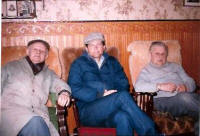
The following pictures also demonstrate different styles of loft coats for fanciers in Belgium.
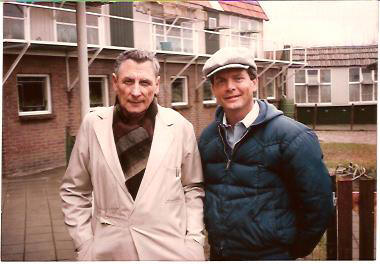 Jos Van Limpt "De Klak" |
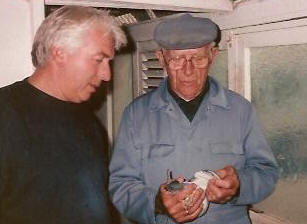 Antoine Jacops and Flor Engels |
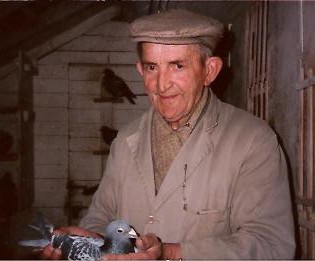 Tist Eyssen - Maria Janssen's Husband |
Mentors can also instill a sense of pride in fanciers about the nuances and traditions of the Sport. Mentors can give fanciers an important sense of history and culture surrounding the Sport. Racing pigeons is not all about pigeons. It's also about people or fanciers. The Sport has a tremendous history. In my opinion, top fanciers should appreciate and respect the Sport's history as well as be students of the game.
The top row of fanciers in the following page of Antoine's Sale Catalogue represents several of his earliest mentors in the Sport - mentors like Emile Verhaert, Warre de Schutter and Staf Van Den Bempt. These fanciers are legends in the Belgian Racing Pigeon Sport. I'm sure most of you have never heard of them. Stambasis, the word at the top of the page, refers to basic or foundation breeders that came from the fanciers on this page of the Sale Catalogue. It has been my experience that fanciers who have never been exposed to high quality mentors who are grounded in the Belgian form of playing the racing pigeon game do not have an opportunity to understand and value the rich history of the sport. Consequently, these fanciers often make political decisions about the game that have little or no basis in tradition or the long-term integrity of the Sport. This is another reason for my website. I want to pass on a small portion of the rich history and tradition of the game so that readers will value the integrity of the sport as played by the giants of the past and present in Belgium. My hope is that readers will want to become better students of the game of racing homing pigeons through reading or viewing drjohnlamberton.com.
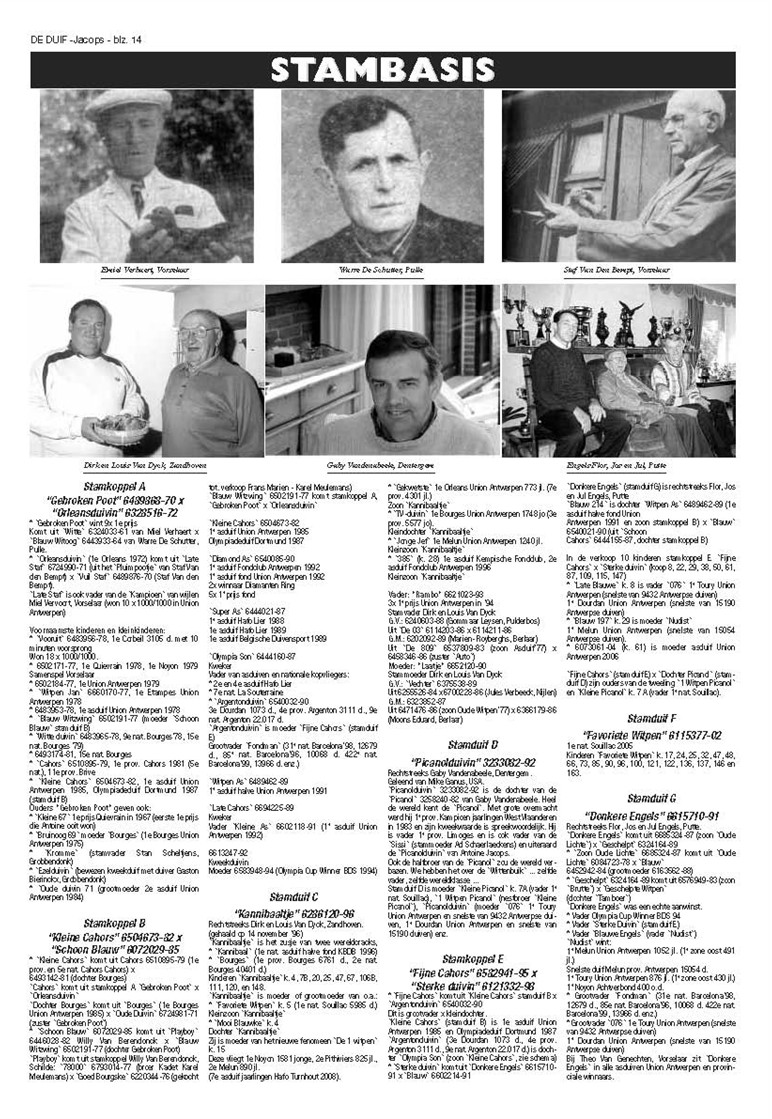
If you don't have a mentor, or even if you do, please consider joining me almost everyday for the Daily Blog and Weekly Videos. Please tell a friend or friends about the website. Please ask them to inform their friends about the blog and videos. Discuss the topics with your fellow fanciers. One of my goals is to spark the same passion and respect for the Sport in each of you that my mentors sparked in me throughout my life playing this fantastic game of pigeon racing.
Today I will couple many of the breeders and most of the race team. Again, to repeat ad nauseum, the process will go very quickly and smoothly; primarily because of the 3 Ps: planning - preparation - premating. Many pairs will be coupled just as they were a year ago. Other couples will be re-coupled with different mates. Also, young females that raced well, in addition to young females specifically set back for stock, are excellent sources for creating new breeding couples. I tend to mention females more than males because females contribute more to the genetic package of young birds than do males. The typical genetic ratio is 60% females and 40% males. females are actually the most valuable commodity in the breeding loft. As I have said before, the annual young bird race series is an opportunity to discover and develop the very best young females for the next breeding season. The following 2008 females represent a few of the potential breeders for the imminent 2009 breeding season:
|
|
|
|
|
|
|
|
As the breeders are coupled, four criteria are continually evaluated:
genotype - pedigree - the line-breeding versus out-crossing dynamic
pfemaleotype - overall body confirmation, feather and eye color
breeding history of candidates and their siblings
training and race history of offspring.
BREEDERS THAT WILL NOT MATE READILY
Occasionally there will be a breeder(s) that will not mate with the selected pigeon or any other selection on coupling day. In this rare case, if it is a male, the offending male is placed in a loft section by himself with as many females as is reasonable and the male is allowed enough time to pick a female. It is uncanny, but pigeons can often select the best mate. I have observed this pfemaleomenon on a number of occasions in the past. If given the opportunity, pigeons will often select mates that are the most suitable for them.
when breeders are coupled, I watch the immediate reaction between the male and female to see that they are exhibiting the necessary degree of passion to qualify as a great breeding couple. Breeding pairs should like each other very much! This pairing qualification is certainly true in racing; but also very true in breeding. Passionate breeding couples tend to breed better youngsters and frequently fertile and hatch more eggs than less amorous pairs.
OVERLY AGGRESSIVE BREEDERS
As I have said before, be very careful to watch every breeding male so they can be stopped if they are too aggressive with a female. Pre-mating can eliminate this problem when coupling breeders. Locking a female in one side of the nest box so that an overly aggressive male can still court the female but cannot hurt her is the simplest method of dealing with this problem.
YOUNG femaleS
Young females sometimes take longer to lay than older females that have previously hatched young birds. Please be aware of this fact especially in case you want to foster eggs. If a young female takes too long to lay her eggs, it may be wise to put her back until she is older.
SMASH TRAINING TOSSES
Smash training tosses are seldom random or accidental. Although I am not an expert on sun spots, solar flares and transmission towers and their potential impact on homing ability, I believe that the root causes of smash training tosses are a result of "problems" or "deficiencies" in loft management. Problems often center around unhealthy or untrained youngsters. Many or most smash training tosses can be avoided by raising healthy young birds and training them properly. The health of the breeders on December 1 is critical to raising healthy young birds. Pigeons can look just fine; but still may be unhealthy. If breeders are not robustly healthy at the time of coupling, all of your efforts and the work of the breeders raising a round or rounds of young birds will ultimately be a complete waste of time. The empirical proof of unhealthy breeders comes in the form of flyaways, lost pigeons, smash training tosses, and young birds that race at the bottom of the race sheet.
Failures in pigeon racing tends to be a result of the "domino effect" of improper loft management. That is, a domino pushed over (a mistake or deficiency) early in the year will significantly impact racing success months later. Unhealthy breeders will ultimately result in lost pigeons or performances at the bottom of the race sheet. Unhealthy breeders may infect other breeders unless they are isolated in individual breeding pens. However, when youngsters bred from an unhealthy parent(s) are placed in the young bird loft, the infected young birds may contaminate the other healthy young birds raised from healthy parents. Respiratory maladies are sometimes very hard to detect. Low grade viruses may be difficult to catch. Pigeons and even their droppings can appear to be relatively healthy when there maybe an undiagnosed problem.
MISCELLANEOUS THOUGHTS
For older males, you may want to pull and remove the feathers completely around the vent and trim about one-third of the tail in order to increase the probability that their female's eggs will be fertile.
Be sure to check the beaks of older breeders. There maybe a few beaks that might need to be trimmed in order for them to eat and feed youngsters properly.
Never try to couple sick or weak pigeons unless they are very old and you wish to get a few more youngsters out of them. In this case, always foster their eggs to healthy pumpers. Always wait until breeders are robustly healthy before coupling. Unhealthy or weak breeders seldom raise robust youngsters that will make strong racers in the fall. The youngsters from unhealthy breeders will usually be lost off the loft or lost in training - often from just a few miles from the loft.
I have tried to anticipate most of the potential problems that may occur on "mating" or "coupling" day. There may be other potential problems I haven't addressed; but I can't remember them at this moment.
Good luck if you are coupling your breeders this week! The first week in December is my most favorite week of the calendar year. Regardless of our race results in the 2008 Young Bird Race Series, the first week in December is a time when our young bird "blackboard" is completely erased. It is a week dedicated to starting over. This week, all over the world, fanciers are starting at square one. The decisions we make this week will have repercussions through the 2009 young bird race series and into the breeding loft for years to come. Breeding season is the most creative time of the year. Enjoy it and have fun with it!
Most of the breeders have been coupled. All of the pairings went very well primarily due to pre-mating. Each pair coupled as if they had been on widowhood and were very glad to see each other. As I said yesterday, the final criteria for coupling a pair of breeders is their reaction to each other when paired. The reaction must be extremely intense by the male and the female. Pigeons have mating preferences. Both males and females can exhibit subtle differences toward different mating choices. While any female will make most males actively display, there will be a particular female that will drive them totally crazy. If a male does not particularly like a female, he will immediately begin driving her, and when he catches or corners her, he will severely peck her head in such a way that she will fear him or fight him back or become indifferent to him. While pre-mating will stem a males aggression over time, a different more acceptable female will usually change his behavior immediately. females that are not particularly attracted to a male will act indifferently, will often stand to the side of the nest box, or will be slow to respond at all.
The reactions of which I am speaking are subtle nuances and are difficult to write about in a way that makes sense and is understandable. Let me suggest that you try coupling different pairs of pigeons and watch their various reactions. The reactions of different breeders will be surprising if you have not observed these differences before. If you have previously observed these differences, you know what I am trying to say. I think these differences are important for breeding and definitely important in racing. Pigeons should be happy and content with their mates as well as their total environment in order to race well and breed well.
In order to document the process through which I go through in mate selection, I thought that I would create an online demonstration. I have selected a beautiful dark splash female from Antoine Jacops that has none of Jacop's old family of pigeons in it, BELG 05 6046881. This female is the only import pigeon that has no old Jacops blood somewhere in the pedigree. She is a cross between the pigeon of the Janssen Brothers and Flor Engels. In order to line-breed this female, I have selected the pedigrees of three males as potential mates for the female. Please study the pedigrees and track the breeding lines. Which one do you like best? As you can see, there are a variety of choices. Let me document several coupling choices for a particular female, BELG 05 6046881. Her pedigree is pictured next. There are several Janssen pigeons that appear in her pedigree. BELG 88 6717695 appears in the female's pedigree along with the YOUNG MERCKX, the mother to the ZITTER, the SCHOUWMAN, and the "019." In addition, BELG 05 6046881's mother is line-bred to the OUDE LICHTE and the "231" of Flor Engels.

The following three pedigrees are mating choices for BELG 05 6046881:
1. BELG 04 6073187. His pedigree is pictured next. In this pedigree the 4th generation shows two Janssen pigeons, including BELG 88 6717695, that also appears in the female's pedigree. when BELG 04 6073187 and BELG 05 6046881 are coupled, their youngsters will be line-bred to the same Janssen pigeons. In my opinion, these two pigeons make a great breeding couple. And, they were coupled last year and I stocked a female, AU 08 LAMBERTON 168.
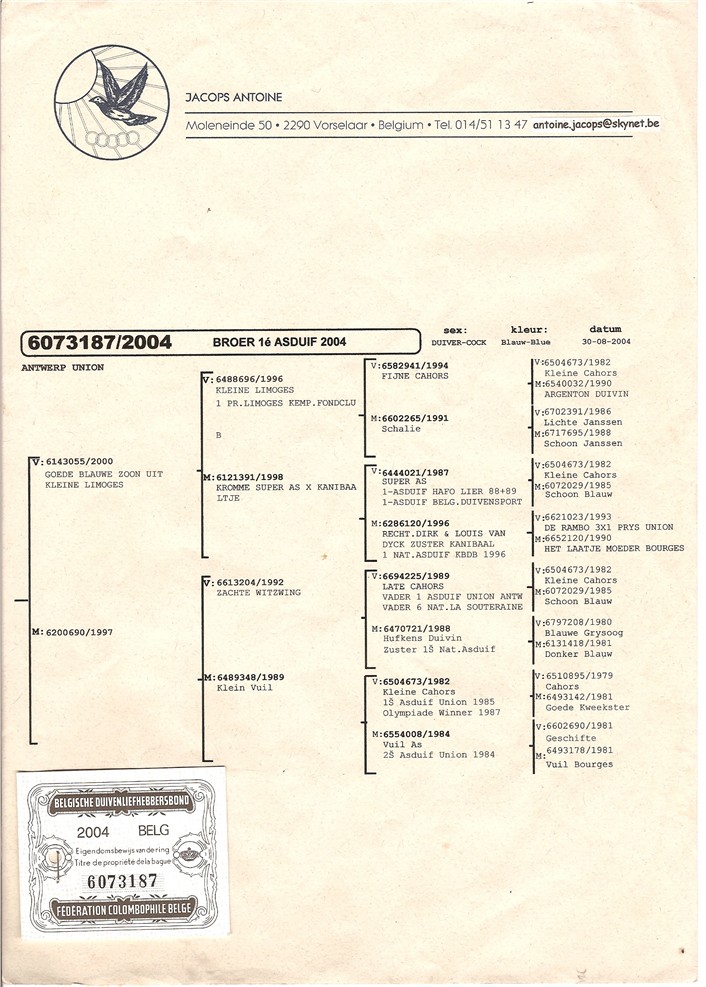
2. BELG 03 6192370. His pedigree is pictured next. As you can see, BELG 03 6192370 and BELG 05 6046881 have the same mother and are half-brother half-sister. Youngsters from this pairing would be 50% Engels - 25% Jacops - and 25% Janssen from the Brothers. Since Antoine's birds are part Meuleman via Willy Van Berendonk, and since Meuleman's Golden Couple was half Janssen, the youngsters from this pairing will actually have a higher percentage of Janssen blood than 25%. The following picture is of Karel Meuleman's Golden Couple: a Vandenbosch male and a Janssen female. In the pedigree of BELG 03 6192370, in the great grandparents column of breeders you will see Den 78000, BELG 77 6793014. This pigeon is a son of Meuleman's Golden Couple picture below.
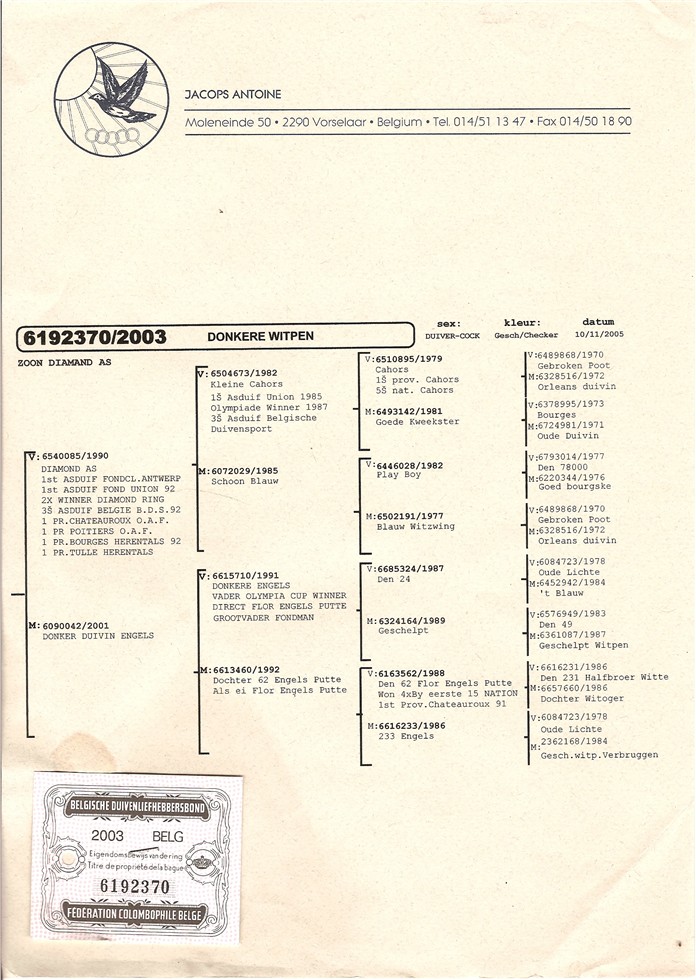
Karel Meuleman's Golden Couple: A Vandenbosch male and a Janssen female.
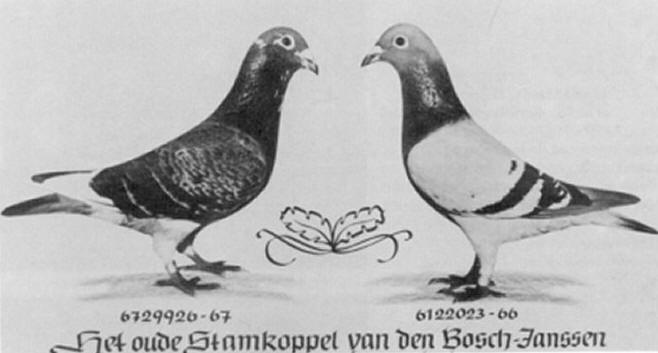
As I have detailed in earlier blogs, the Vandenbosch male goes back to the pigeons of Rene Maas just like Antoine Jacop's pigeons through his original White male. Consequently, Jacop's family of pigeons are line-bred to the fantastic pigeons of Rene Maas through the Meulemans Golden Couple (the dark check male in the picture) that Antoine crossed into his old family of pigeons down from his original Witte (white male). Very interestingly for me, I paired this couple together last summer and raised an outstanding white male, AU 08 LAMBERTON 209, that went straight to the breeding loft.
3. BELG 05 6046862. His pedigree is picture below. BELG 05 6046862's father and BELG 05 6046881's mother are brother and sister - making the couple first cousins. Youngsters from this mating would be line-bred to the Engel's pigeons; but not as close as the former half-brother half-sister couple. This couple would also form a great breeding couple.
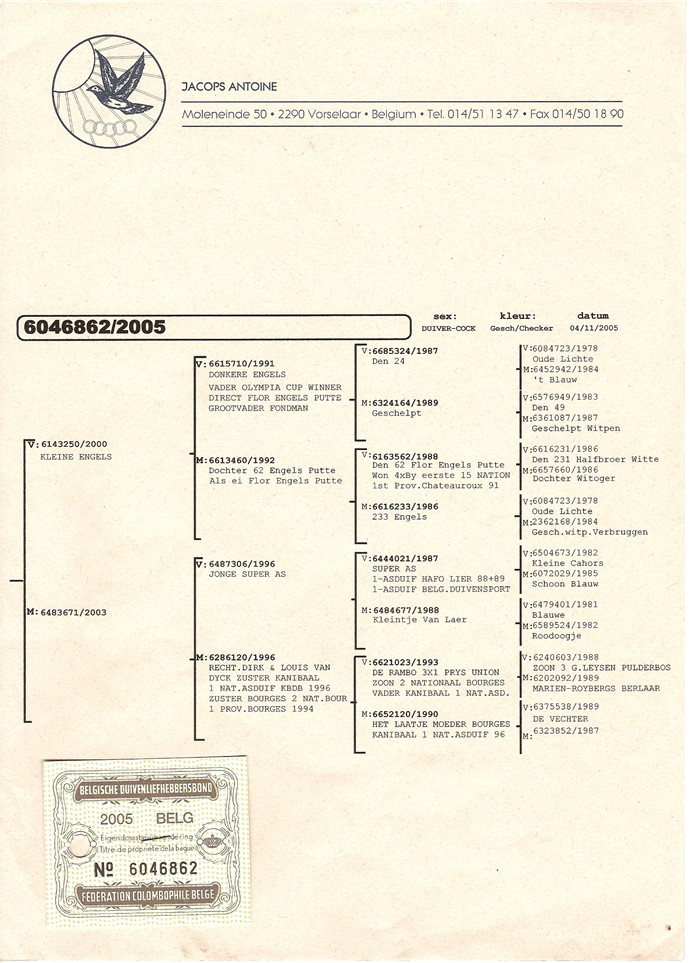
The mate I chose for the first round or two out of BELG 05 6046881 is BELG 03 6046370, the LAST DIAMOND. Although a half-brother half-sister mating is the most in-bred mating of the three choices, AU 08 LAMBERTON 209 white male is so outstanding that I wanted to raise more like him to race in the young bird race series.
NUMBER ONE
I was studying the Sales List for Antoine's pigeons today with a sad heart. However, it occurred to me that while the sale appears to be the end of a great era and dynasty of pigeon racing in the Antwerp Union Belgium for over 40 years, it may not actually be the end at all. Antoine's pigeons are great because they are great pigeons. But they are also great because of Antoine's personal code of decision-making that guides him daily in playing the game. As I have said before, Antoine began to play the game in 1967 with 50 pigeons that he paid a great deal of money for - a great many Belgian francs. At the end of his first race season he had 28 of the 50 pigeons remaining. It was at this moment that Antoine set the course for his pigeon game in a straight line for success. Antoine evaluated his race team and eliminated all of them except for a single white male. This white male became known as the Oude Witte and founded Antoine's dynasty of pigeons!
Just think about it. How many fanciers would have the courage to do what Antoine did? How many fanciers, including myself, would have the courage to say that only one of their pigeons meets the quality that they seek in their lofts and then act on their beliefs by eliminating 27 out of 28 pigeons on the team? If 27 pigeons out of 28 pigeons did not return from a training toss or race, most fanciers would be wringing their hands with self-criticism. What did I do wrong? I used to; but not anymore. Several years ago my friend Tony Smith was in the midst of such a "smash" training toss. He called seeking the support of a friend and was lamenting what mistakes he had made to cause such a catastrophe. While I very much understood his concern and empathized with his dilemma, I told him that once the first bird returns from training that he is off the hook. Why? Because if one bird returns, they all could have returned. This philosophy is an off-shoot of Antoine's initial decision in 1967. If only one pigeon was good enough to return or to stay in the loft, then so be it.
WHAT WOULD ANTOINE DO?
Antoine's pigeons are great not only because they are great pigeons; but because of Antoine's unbridled commitment to excellence. There are many fanciers that say they are looking for number one; but there are very few fanciers who will only keep number one! Antoine's pigeons are great because Antoine has the mental discipline and courage to act upon his skill and the results of the race sheet and make a decision to eliminate everything but number one. While next week Antoine's pigeons will be scattered all over the world, Antoine's philosophy remains with those fanciers with whom he has touched either directly or indirectly. You may never meet Antoine Jacops; but you can read about his philosophy in this blog. Why do I spend so much time and energy repeating Antoine's mantra? Because it works!!! While you may never own a Jacops pigeon, you can own Antoine's passion and commitment to excellence. By reading this blog and watching the videos, my intent is to pass on the ideas of this great man to a world-wide fancy that wants to succeed in a wonderful hobby that levels the playing field among people: the young and old, the large and small, the athletic and non-athletic, and the rich and poor.
Racing pigeons have allowed me to manage the impacts of the physical challenges incurred during my lifetime because of carelessness and random chance. (I have experienced multiple ranch-related accidents that have resulted in permanent physical disabilities. I thought I was being smart by trying to perfect the wrong way of doing something.) Since the pigeons actually fly the races, all I have to do is care for them "properly" in order to play in a game of competition. During the span of time I have played the game, Antoine Jacops and Mike Ganus have defined for me the meaning of the word "properly." The incredible decision that Antoine made in 1967 with the Oude Witte is still at the core of successfully playing the racing pigeon game today. It doesn't take more pigeons to race well - it actually takes less. The Jacops mantra is as follows: Only keep number one! Conversely, only number one pigeons should be added to the existing gene pool (out-crosses).
Although Antoine's lofts will be empty in a few weeks, our minds and hearts can be full of his passion and commitment to excellence. In order to play the game at the top of the race sheet, we should be committed to excellence and we should be committed to only keeping number one. As I evaluate my pigeons on a daily basis, the story of the Oude Witte continually reverberates in my mind. Is this pigeon a white male? Is this pigeon a number one? What would Antoine say? What would Antoine do?
NEW POLICY: Starting this week, the majority of pigeons offered for sale will be listed on this website only.
During the second week of December, breeding pairs should be coupled together under lights for about 18 hours. Breeders will lay the first round of eggs soon which should hatch at the end of the month. Youngsters should be ready to ring in early January. Each year involves the exact same management schedule. In Belgium, fanciers are performing the same functions this week that they have performed for many years at this exact time of the year. There is very little, if any, variation from year to year. I suggest that you make yourself a calendar. Begin it in the middle to late October. In late October, as the young bird races wane in Oklahoma, it is time to begin to medicate the breeders and begin to plan the next year's breeding couples. The breeding loft should be thoroughly scraped, swept, cleaned, and disinfected. If breeders have been relocated to an aviary or some other loft, it is time to place them in their breeding boxes. The necessary preparations should be made for coupling around December 1. Depending upon the number of breeders to mate, coupling could take from one day to several days. Remember that coupling is often a process that may need to be altered depending upon the preferences of the breeding pairs.
THE IMPORTANCE OF NESTING MATERIALS
In addition to clean breeding lofts, breeding boxes should include clean nest bowls. I use carpet pads that can be purchased from the pigeon supply houses although functional pads can be made out of many different types of padded materials. Be sure to place nest building materials in the loft. Nest building is a very important part of the mating process and solidifies the relationship between breeding couples and their nest boxes and bowls. I use long thin pliable pine needles that I gather from several locations within the city on the loft floor so that the breeding males can fly down to get them and easily fly up to their box and deliver the needles to the waiting females lying in nest bowls. For race pairs that are lofted, I sprinkle pine needles in the grass in front of the loft. I force the males to fly in and out of the loft many many times in order to build a proper nest with their females. Nest building is a very important process to breeding pigeons psychologically and physically. I have already mentioned the psychological benefits. But physically, nest building can strengthen males and reduce any excess weight they may have gained during the off season. Nest building usually leads to physical fitness. Never short-cut or minimize this important function of the breeding process.
LEARN ABOUT YOUR BREEDERS FROM THE NESTS THEY BUILD
Garner plenty of building materials so that the breeding pairs do not run out before they are ready to stop building their nests. I prefer that they stop building their nests on their own - because they were satisfied with the structure of the nest - rather than because they ran out of nesting materials. Particularly watch the 2008 pairs (young birds) that have never bred youngsters before. I have often seen a correlation between their quality as breeders and the type of nests they build. The males and females that are the very first to build their nests are often the best breeders. The males and females that build the best and/or tallest nests and use the most building materials are often the best breeders. Homing instinct is grounded in passion - a passion for mates and boxes. The most passionate pigeons tend to build the best nests and the tallest nests. These pigeons often make great breeders because they pass this passionate love and concern for their mate and their nest on to their youngsters. Passion is the fuel or energy source for motivation. Motivation wins pigeon races.
After placing pine needles on the loft floors, I frequently check the lofts in 30 minute intervals. when I find new pairs of breeders that have built their nests completely over the bowls in a short period of time, my experience has been that these pairs will breed very competitive young birds. Nests of pine needles are often excellent indicators of the quality of the youngsters that will be hatched from breeding pairs. I am thrilled when I enter the breeding lofts a few hours after placing plenty of clean pine needles on the floors of the breeding lofts and find a number of young breeding pairs that have built large nests in a short time period. To me, that has always been a very good sign of the quality of the young birds I have selected as future breeders. On a number of occasions, after the breeders are finished and the nests are built, I have needed to remove a portion of the nests in order to prevent the future eggs from rolling out of nests that are taller than the lips of the nest bowls. Immediately after laying the first egg, adjust the size of the nests to fit the nest bowls in order to protect eggs from accidently rolling out of the nests and quickly chilling in the winter's cold temperatures.
If your breeders are coupled nicely, now place plenty of high quality nesting materials in the breeding lofts and outside the racing lofts. Pigeons are no dummies. They will find nesting materials quickly after they have completely coupled with their mates. Watch for the males that find and respond to the nesting materials first. Again, they often have the strongest passion for their mates and their boxes. Consequently, they make the best breeders because they pass this passion to their offspring. Racing pigeons with little or no passion for their mates and boxes are homers and not racers. All of the time and expense spent breeding youngsters out of these types of breeders will be wasted because their results will usually be found towards the bottom of the race sheets.
Please do not make the mistake of thinking that hard working breeder males are building nests completely on their own. Just as in people, females can excite their mates to work hard. Hard working males are often responding to very domestic females that are also passionate about the quality of their homes or nests.
I have often heard so many fanciers claim that selecting the best pigeons is too difficult and something beyond their abilities. All I have to say to that statement is open your eyes! Each and every detail about homing pigeons tells stories - gives clues - creates information. The problem isn't that pigeons are hard to read. The problem is usually that fanciers often discount or ignore what they see and hear. Evaluate each nest. Evaluate how long it took to build each nest. Evaluate the heights of each nest - the thickness - the quality: are they round, are they even, etc. How meticulously were they built? All of this external information during the breeding season paints a picture about the internal quality of pigeons. The most relevant question for fanciers as it pertains to their success playing the racing pigeon game is are they able to see the plethora of information in front of them presented on a daily basis and can they interpret its meaning in order to maximize the quality of their decisions and choices in the breeding and racing lofts? Suggestion: Never ignore anything or take anything for granted. Every detail has meaning. Catalogue details to create a data base of relevant and important information that will provide a cumulative road map for future decision-making.
If you want to test your young birds and have a great time also, please enter the upcoming 2009 Texas enter Convention Races and attend the Convention July 14 - 19 in Tulsa, Oklahoma. Click on this link to view the races offered in 2009. Basically, there are 5 race categories: A, B, C, D, and E based upon the cost of the entry fees and the race format. The A and B races are 3 birds for $150 plus a $25 perch fee per bird. One bird will be placed in each of three lofts. The C and D races are $100 per bird plus a $25 perch fee and are one loft races. The E race is $250 per bird plus a $25 perch fee and a one loft race. My lifelong friend and super pigeon fancier Steve Trotter is hosting this "high-roller" race. Steve is an excellent fancier and will have each bird perfectly ready to go on race day. I encourage all readers to enter a bird(s) in the E race if your wallet will allow you to do so in these challenging economic times. You will learn a great deal about your best birds from this race as well as have a chance to compete for sizable winnings. Birds can be sent from February 1 to April 1 with replacements accepted until April 15, 2009. The E Race is open to only 75 entries.
Perhaps a youngster(s) from the pairs you have just coupled will score at the top of the race sheets in July! Someone will. It might as well be you. Select your best youngster(s) from the 1st or 2nd round and send it/them to Tulsa. All of the Convention races will be good ones. So please consider entering one or more of these races after you have recovered from the holidays.
One of the myths that I have attempted to de-mystify is the notion that the shipping crate is the only true measure and accurate evaluator of the overall quality of racing pigeons. I hope that you are beginning to realize by reading this blog covering many aspects of pigeon racing that there are many subtle ways to evaluate your pigeons. For instance, in my experience, I have found that the size and type of nests built by breeding pairs can be a significant indicator of high quality racers and breeders. For instance, the passionate interaction between the male and the female can be quantified by the eventual height and volume of the nest of pine needles (the number of pine needles used in the nest) after the nest-building phase of courtship is over. The breeders with the tallest nests, or nests above a certain height, will often be good breeders and racers. During the summer months of each year, I am thrilled to see the nests built by young males mated to old females as they are readied for the young bird race season. Young males that fill their nest bowls several times over have a high probability of becoming the best racers on the team. Why? Because the height and volume of a racer's nest can be correlated with the depth of a racer's passion for his mate and nest and the amount of work he is willing to put into his home and relationship with his mate. Very few events or predictors are 100% accurate. Predictors are a function of probability rather than exact science. Science is based upon probabilities. There are seldom predictors with little or no margin for error. So, I record and make notes on those young birds who build full nests and rate them as high probable's in terms of their racing potential.
PROBABILITIES
Life is an inexact science. For whatever reason, that's the way it was set up from the beginning. Life can be visualized as a road down which we walk not knowing for absolutely sure where we are going or why we are going there or if we should be going there at all. Absolute. That's a word that tends to be like mist or vapour. when we try to touch it or grab it - it slips through our fingers. Life teaches us that absolutes tend not to be absolutes after all. Consequently, we are left to choose to believe in absolutes through faith - it could be a faith in ourselves - a faith in our families and friends - or ultimately - a faith in God.
The game of racing pigeons mirrors the inexactness of life. Why? Because the game is created by people - not pigeons. Concerning pigeons, here are many types of racing homers:
There are pigeons that fly away from their loft as squeakers.
There are pigeons that can't find their way home from a few miles away.
There are pigeons that can't find their way home from 30 miles away.
There are pigeons that can't find their way home from 60 miles away.
There are pigeons that can't find their way home from 100 miles away.
There are pigeons that can't fly more than 100 miles.
There are pigeons that can't fly more than 200 miles.
There are pigeons that can't fly more than 400 miles.
There are pigeons that can't fly more than 600 miles.
The pigeons we cull from 100 or 200 miles are often the best pigeons to race from 1,000 miles.
Pigeon racing, like life, is not absolute. It's a guessing game. It's based mostly upon probabilities and seldom on absolutes.
STARTING TO PLAY THE GAME
In the beginning, fanciers should determine what type of game they want to play, and then to match those goals against pigeons with which they start. Pigeons that are given to them. Pigeons that they purchase. Few fanciers begin the sport by learning about the game before they obtain pigeons. Which of the types of pigeons listed above do they have in their lofts? Short distance? Long distance? All distance? Also, most fanciers build their lofts before they know what type of loft they ultimately want and/or need. Fanciers become financially and emotionally invested in their loft and their pigeons before they understand the type of game they want to play. Once they are invested, changing becomes very difficult.
Typical fanciers in the Antwerp Union invest themselves in performing well rather than in certain pigeons. Just because a pigeon is a son or daughter or granddaughter of "Old Blue" has little bearing upon their investment in a pigeon. Their primary concern is did the pigeon perform well?
when new fanciers begin to play the game, they probably should ask themselves how they want to play it? They probably should match the pigeons they obtain with the game they want to play. Is it vitesse (speed)? Is it mid-fond (middle distance)? Is it fond (long distance)? Is it grote fond (very long distance)? Is it all of these races?
Pigeon racing, like science, is built upon probabilities. when pigeons are coupled, the question a fancier should ask becomes - is it probable that this couple will produce offspring that will compete well at the type of game I am playing? when pigeons are sent to races, the question becomes - is it probable that this pigeon is going to compete at the top of the race sheet?
Because many fanciers have not studied the sport and its history, they don't know the answers to these questions. Consequently, in lieu of not knowing, their strategy becomes raising and racing as many pigeons as possible. The more pigeons sent to a race, the higher the probability that one of them will perform well. As long as everyone plays a similar game, that type of racing may bode well. But once a single fancier learns to play the game like the Masters, say the Masters in Belgium or Holland or Germany or England, or the Masters in the Antwerp Union, the game will change. Why? Because it is better to race one pigeon well than many pigeons poorly. One super young pigeon mentored and managed well throughout its short lifetime and properly motivated to race home rather than fly home, will out-perform masses of pigeons almost every time. If the goal is to win a race, send a few highly-qualified highly-motivated pigeons to the race. If the goal is to win a race series, send a few highly-qualified highly-motivated pigeons to every race. Depending upon the environmental conditions and weather, it may take more good pigeons to win a race series in certain geographical areas than in other areas. But the number should seldom be higher than 20 to 25 pigeons.
INVESTMENTS
Let me caution that while investing our emotions and energies are perfectly natural human attributes, investing ourselves is often inhibiting if the goal is strictly winning. Investing often blinds us to change. Investing often creates frustration. Why? It is usually foolish to put the same effort in the same thing and expect a different outcome. Different outcomes usually involve changes. Before one changes loft construction or pigeons, fanciers should consider changing themselves.
If your goal is to win or perform near the top of the race sheet, may I suggest that you invest yourself first in performance standards before you invest yourself in a loft or in certain pigeons. If your goal is to simply enjoy your pigeons and your friends and have a good time regardless of performance, then please disregard these comments immediately. Why? Because you have discovered a secret about the sport that many of us never know. The secret of happiness and contentment.
While winning is fun, only one pigeon can do it per race. Consequently, performing well every week should probably be coupled with a healthy appreciation for our pigeons and friends that goes far beyond the intensity of winning. The intensity of winning often creates an emotional yo-yo in which fanciers are either happy or sad each week depending upon the performances of their pigeons.
If my birds perform in the top 20% of the race sheet, I am usually well-satisfied. The Dutch and Flemish usually talk about the performances of their pigeons in terms of prizes. Although it changes, in many races, prizes in Belgium are allotted at a ratio of 3 to 1. That is, the top 33% of the race sheet gets a prize. In terms of the AU Champion Award, the AU is far more stringent. Prizes or points are allotted at 20 to 1.
Investing completely in winning should probably be blended with a healthy investment in fun and friends. Mentally and emotionally, it seems much healthier and happier that way.
THE PERFORMANCE BAR
After his first season of racing pigeons, Antoine eliminated 27 of the 28 pigeons that remained from the 50 pigeons with which he started the season. He did not pine for the 22 that were lost while racing. He did not pine for the 27 he eliminated. He was not invested in the pigeons that did not meet his performance criteria. He chose only to invest himself in one pigeon - the OUDE WITTE - the OLD WHITE male. Because he chose not to invest his mental energies and his emotions in those pigeons whose performance was not up to his chosen standards, eliminating pigeons was relatively easy. What would be his legacy today if he had kept all 28 pigeons after his first series of races and bred from them? Do you think he would become the champion fancier that he is? Probably not!
Pigeon racing is a game created and maintained by people. People chose the distances and the race schedule. In order to play the game well, we must match our pigeons, our lofts and our strategies to the game that is played in our area. Unless you were mentored by a truly caring person, chances are the pigeons that you were given when you started are not going to be good enough to play the game at the top of the race sheet. Unless you obtain pigeons from fanciers who play the game the way you want to play it, the struggle to raise pigeons that will race your system properly will take some time to achieve. In the case of widowhood, there are a number of pigeons that do not compete well in this system. It often takes time to produce good widowhood pigeons and to properly teach them the system. It usually takes a few years to build up a superior old bird team.
If on training tosses or actual races, choose to invest yourselves in the pigeons that return home in the top 1/3 of the race sheets. Gradually raise the performance bar until your pigeons are returning in the top 20% or even the top 10% of the race sheets. Have patience. Performing well usually takes time. If you choose those few pigeons that race your system very well and breed from them, in a few years, you should have a whole loft of them.
FYI: 11th NATIONAL ACE DUIF MID FOND BELGIUM 2008

The mother of this pigeon is a daughter of the MINIEM, the 2nd Ace Duif Union Antwerp 2002 when coupled with a daughter of the YOUNG SUPER ACE. I have offered for sale this week a female that is a daughter of a full brother to the MINIEM coupled with a daughter of a full sister to the MINIEM - AU 08 LAMBERTON 73. 73 is bred even a little closer or tighter than the mother of the 11th National Ace. The birds I currently offer for sale are the exact same pigeons that are competing at the top of the race sheet in the Antwerp Union year after year. That corollary means a great deal to me because I am thrilled to offer such brood stock to the fancy.
STARTING FROM SCRATCH WITH A SMALL LOFT
A fancier asked me to comment on how to start to play the game with an 8 X 12 foot loft divided into three sections. At first glance, it seems logical that one section would be for young birds - one section would be for old birds - and one section would be for breeders. Given this division, however, there is no room for feed and supplies and a few extra birds or a small hospital or quarantine area. Also, the loft division into thirds begs the question how are the race birds to be motivated?
Looking at the loft from the roof down into each section.
| Nest boxes | Nest boxes | Nest boxes |
8 feet 4 feet |
4 feet |
4 feet |
12 feet long
In this loft scemata, each small section is 4 feet by 8 feet. One way to race a widowhood system or a separated sexes system would be to build nest boxes across the back of each section: 2 boxes wide and three boxes tall. That yields 6 nest boxes. Make sure that the nest boxes begin about waist high and go to the ceiling. The ceiling should be a couple of inches above the head so that the pigeons cannot fly over one's head when they are handled. To separate the sexes inside each loft section, construct a small area that is completely sheeted with wood under the set of nest boxes in each section so that the birds in the nest boxes cannot land on the floor and see the pigeons in this new small area under the nest boxes. Obviously there should be a door into this area in order to feed and water the six pigeons housed in this area under the nest boxes. Place six perches in the new area under the nest boxes. Cut holes in the back of the loft so that the pigeons in the new areas under the nest boxes can get outside to sun in a small aviary. The following schemata depicts this construction of the loft.
Looking at the loft from the front to the back.
| nest box | nest box | nest box | nest box | nest box | nest box |
| nest box | nest box | nest box | nest box | nest box | nest box |
| nest box | nest box | nest box | nest box | nest box | nest box |
larger sheeted section with door to front and door to small aviary in back. |
larger sheeted section with door to
front and door to small aviary in back. |
larger sheeted section with door to
front and door to small aviary in back. |
|||
Whether a small loft is divided in the manner in which I have described or another way, each racing section - young birds or old birds - needs to be divided in order to separate the sexes from seeing each other. In the schemata presented here, in order to couple the pairs, the door on the front of the larger section underneath the nest boxes can be opened so that the pigeons can enter the loft section and fly up to the nest boxes. If a section is not split within the section itself, but instead mates need to be moved from a section of the loft outside the the old bird or young bird racing sections, then the interior of the loft will need to be completely rebuilt and a 12 foot hallway would need to be constructed along the entire front of the loft in order to transfer mates from one section of the loft to another. See the following diagram.
| Hallway |
The hallway would allow pigeons from one section to be driven out of their section and down the hallway into another section. Whether loft sections are split within themselves or whether a hallway is used to create a pathway among all of the loft sections, the sexes will need to be separated in order to race a system of widowhood. Even the breeders will need to be separated at the end of breeding season. Using a natural system of racing would allow the males to stay with the females; except in the off-season.
Often, small fanciers in Belgium do not have "breeders" per se; or if they do, it is only a few pairs of breeders, i.e., retired racers. Why? Because they use their old bird race team as breeders for the young bird team. If the old bird race team doubles as the breeders, a section of the loft can be eliminated.
With six nest boxes in each racing section of the loft, 12 pigeons can be raced: 6 males and 6 females. In young birds, the old birds can serve as the mates for the young birds. Or, the young birds can simply be split males/females and re-coupled at race time. As you probably know, I prefer coupling young birds with old birds for the many reasons previously discussed.
If the breeding section is eliminated, then the entire loft can be divided into four 3' X 8' sections. By using smaller nest boxes, the size of the race teams can be doubled from 12 to 24 young birds and old birds.
Just because a loft is divided into existing sections doesn't mean that the loft cannot be modified. Try using a generous amount of drawing paper to conceptually rebuild the loft interior in the manner that suits your management system best. Conceptualize the loft that simplifies each daily and weekly task. It is not wise to "put up with" or tolerate major inconveniences and logistical hardships because you don't want to disturb the pigeons. I assure you, pigeons will quickly readjust to almost anything and you will be much happier with a loft that makes your job the easiest to accomplish and most productive to achieve. The loft should serve you; not work you to death.
CAUTION: With a small loft, selection becomes a fancier's Achilles Heel. A small loft dictates that one must select only the very best pigeons to keep each year. It also dictates that when a pigeon is kept, another pigeon must be eliminated. Only a few pigeons can be properly kept in an 8' X 12' loft. If a fancier who uses such a loft is not brutally selective, the negative complications that always accompany overcrowding will quickly dominate the conditions in the loft and performances at the top of the race sheet will be few and far between.
Antoine Jacops began playing the game with a perfect pair of pigeons: the OUDE WITTE and the BLAUWE DUIVIN. This initial building block was as perfect a start as was possible at the time. These two pigeons came from two of the very best older well-established and winning fanciers in the Antwerp Union. Antoine began his first year by purchasing 50 pigeons. No one gave him a single pigeon. He bought his way into the sport. He didn't rely on the generosity of others to "give" him anything. He wanted only the best and was willing to pay for it.
It is my personal belief that Antoine's method of entering the sport is the best way in both the short run and in the long run. It is best to purchase the best pigeons possible regardless of money. Let's face it. It costs money to have a hobby. It costs money to play golf, or tennis, or ride horses or show cattle, or jog or bicycle. All animals, especially dogs and cats involve spending money on food, medicines, veterinary bills, etc. There are few things that we can do in life for free. Most hobbies cost money. In America, it seems to me that we tend to devalue the worth of pigeons such that new fanciers often expect to receive "free" pigeons in order to start playing the game. Often, fanciers unload their extra pigeons or their culls upon new fanciers. Sometimes, generous and philanthropic fanciers will give new fanciers excellent young birds or eggs in order to start. In this case, new fanciers can get a leg up in the sport. However, in the former case, fanciers will spend years trying to breed themselves out of a deep hole of mediocrity. After several years of frustration, they may give up the sport entirely.
Like Antoine and myself in 1961, I think it is best to purchase good pigeons with which to begin playing the game. Just because fanciers purchase pigeons doesn't mean the pigeons are good ones. Purchasing pigeons is designed to increase the probability that the pigeons purchased are good ones. And while this doesn't happen with every purchase, it still seems like a better way to start than relying completely on charity - unless new fanciers have a special venue to receive high quality pigeons as a gift. Good pigeons don't need to cost a lot of money. One of the best females that I ever purchased was at the dispersal auction of an older successful fancier who was quitting the sport. At that auction in 1983, I purchased a female for $5 that produced a futurity winner the next year. Today, I enjoy breeding from Belgian and Dutch pigeons because I think they are genetically superior to other pigeons and tend to breed more good pigeons than pigeons from other places that were raced in less stringent systems.
The OUDE WITTE and the BLAUWE DUIVIN bred a number of excellent racers including the GEBROKEN POOT (BROKEN FOOT or LEG). This wonder pigeon was not only a great racer - 9 times 1st prize; but also a great breeder. He sired a number of excellent racers including the CAHORS - 1st Provincial and 5th National Cahors, the VOORUIT - won the super pool 18 times, the 171, the 184, and others - all 1st prize winners. The CAHORS went on to sire the KLEINE CAHORS (SMALL CAHORS) that was 1st Ace Antwerp Union 1985 and 1st Olympiade Ace Dortmund Germany in 1987. The SMALL CAHORS coupled with a daughter of Willy Van Berendonk's Meuleman-based pigeon, the PLAYBOY, bred the SUPER ACE, the WITPEN ACE, and the DIAMOND ACE, to name a few of the best.
Linear Progression of Descendants of the OUDE WITTE
| GERBROKEN POOT - 1970 | CAHORS - 1979 | SMALL CAHORS - 1982 | SUPER ACE - 1987 | DIAMOND ACE - 1990 |
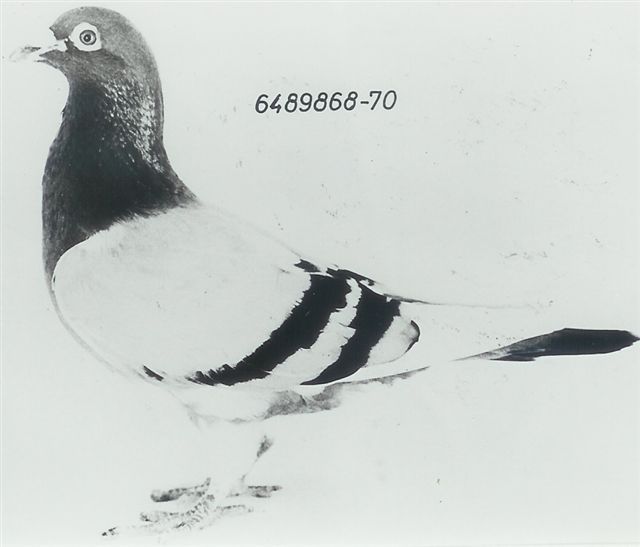 |
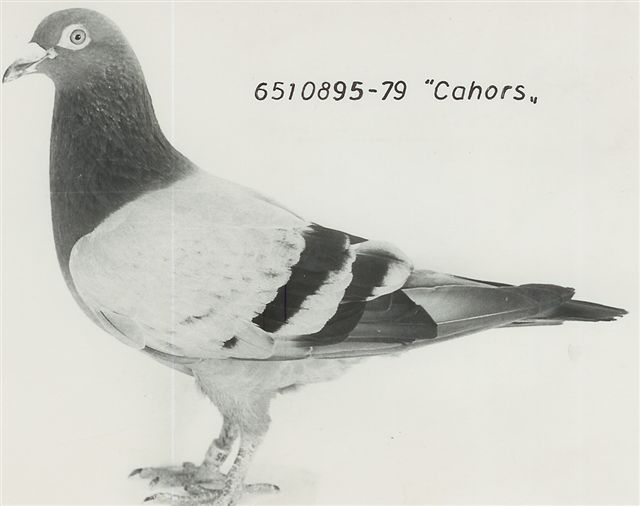 |
 |
 |
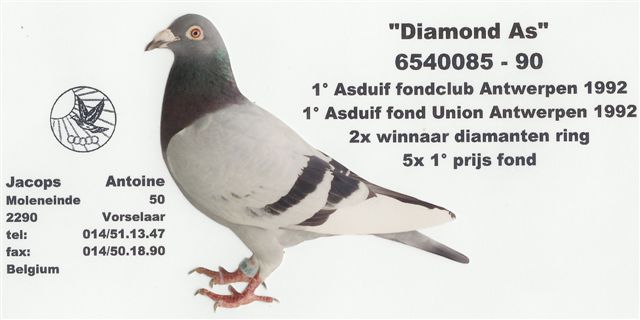 |
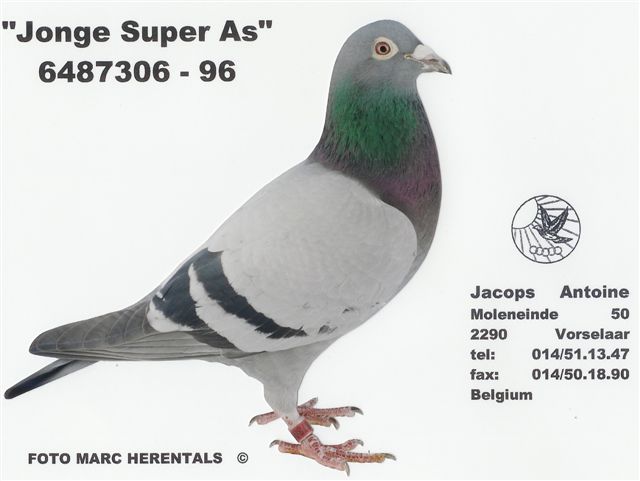
Today, the children and grandchildren of the SUPER ACE, the DIAMOND ACE, and the YOUNG SUPER ACE are winning in the Antwerp Union.
Look at the linear progression of excellent pigeons bred down from the OUDE WITTE and see that the quality of the initial pigeons that Antoine obtained to begin his tenure in the sport was absolutely critical to his achieving and sustaining the exceptional long-term success that he has enjoyed. In Antoine's loft, each generation was as good or better than the preceding generation - both racing and breeding. In order to accomplish this fete, Antoine selected only the very best pigeons from 40 years of racing and crossed them with the best pigeons he could obtain in Belgium from other notable fanciers. Over the past ten years, Antoine's primary outcross has been the pfemaleomenal sister to one of the greatest pigeons of the last decade - the KANNIBAAL - 1st National Ace Middle Distance Belgium in 1996.

In the past ten years, Antoine has probably bred about 75 young birds per year to race in the young bird race series. Over ten years, that's a total of about 750 pigeons. Probably less than a dozen of those pigeons have truly impacted Antoine's breeding loft. That's perhaps 12 pigeons out of approximately 750 bred. That's "not so many" to use Antoine's translation. May I suggest that new fanciers begin playing the game with excellent pigeons whether they receive them as a gift or they are purchased. It will save years of frustration trying to shove a square peg in a round hole - trying to score at the top of the race sheet with pigeons bred from mediocrity. Even great pigeons breed mediocre racers. Remember the Lamberton 10% Rule? Be careful not to invest your feelings in mediocre pigeons just because they were the first pigeons that you received and breed from them over and over without the type of success that makes you happy. Eliminate the poor, the mediocre, and even the good pigeons; and keep only the very best. It's a winning formula as evidenced by the super pigeons of Antoine Jacops.
FEEDING DURING THE WINTER MONTHS
I received a very nice email from a fancier interested in feeding racing pigeons. So, let's discuss winter feeding. Yesterday was 70 degrees F in Tulsa and set a record high temperature for the day. Last night, a sleeting cold front went through the state of Oklahoma. Although the accumulations of ice are not extremely bad, driving is somewhat hazardous and the morning temperature is 16 degrees F with a wind chill of about 0 degrees. The presence of hawks around the loft area will be very bad now since food will be very scarce due to the wintry weather. when the racers are exercised over the next few months, I vary the time of the exercise periods so that the predators are not able to predict the daily loft routines. Hawks are incredibly smart and quickly learn when their next meals are available for hunting. Needless to say, the pigeons will probably not be getting out of the loft for several days now due to this cold weather snap. Those of you that live north of Oklahoma may have been experiencing much worse that this for some time now.
when the pigeons are kept in the loft during bad weather, I often add a portion of barley to the feed in order to keep their weight in check. I'm not talking about the breeders that continually remain inside the loft; but race birds and/or other pigeons that regularly exercise outside the loft. The racers are often fed differently during inclement weather when they cannot exercise. Racers that are kept inside and fed a rich diet will generally put on weight in the form of body fat. when they are eventually let out for exercise, they cannot respond as quickly to predators due to their weight. Consequently, they are sometimes eliminated from the loft by observant and crafty predators. Be careful exercising racers that have added weight due to inactivity until any potential threat from the skies is minimized. Either keep them inside the entire winter or add a significant portion of barley to their daily food intake. Fat pigeons, even the best racers, are no match for lean and hungry hawks bearing down on unsuspecting pigeons from the angle of the sun. Buoyancy is a product of exercise and proper feeding. Buoyant pigeons have the best chance of staying alive outside of the loft - especially in the winter. May I suggest that you keep your racers as buoyant as possible if you intend to exercise them during the winter.
Further, fat pigeons or lethargic pigeons are susceptible to various maladies including respiratory diseases. If your pigeons are continually fluffed and lethargic with their eye lids half shut, they maybe experiencing respiratory problems. You may want to analyze some of their droppings. Always - but especially during the winter, store pigeon grain away from rodents. Rodent excrement on pigeon grain can quickly affect racing pigeons in very negative ways. Grain can develop fungi that is toxic to pigeons if not stored properly. The same is true for water and grit containers. It is also important to keep feed away from moisture and dampness. Store feed so that it remains clean and dry.
PREDATORS
Also, traps or any other types of loft entry portals should be securely covered so that hawks and owls cannot enter the loft by day or by night. Several times over the past 40 years in the sport, I have unexpectedly entered a race loft with an uncovered trap to be surprised by an intruder trying to exit the loft out the door past my head. On these occasions I have quickly protected myself with a nearby broom. Although I don't like to kill any type of wild bird, once predators learn to enter the loft, they become very dangerous. Such birds will often wreak havoc when I forget to follow every single safety precaution every single day. If something bad can happen, it often will. The winter months are a dangerous time for champion racers and every precaution should be taken to maximize their safety. In spite of all precautions, occasionally, the unthinkable happens and a great racer can be unexpectedly eliminated from the loft in the blink of an eye. Because of the Australian Shepherd dogs on the Ranch and around the loft, the fear of land-based predators is extremely low. Air-born predators are another matter.
BUILDING MATERIALS SAFETY
If there is some type of light-weight wire on the loft or used for aviaries, I recommend that it be replaced by a heavy gauge wire or wire cloth with a small mesh. I have spoken with fanciers who have lost pigeons through chain link with a wide mesh or through chicken wire with a light gauge wire. I have spoken with fanciers whose pigeons have lost their feet and/or legs while roosting on a loft floor with wire mesh when a possum or coon ate their legs and feet while the pigeons roosted. One time, a friend brought over a perfectly healthy-looking pigeon whose legs were cleanly removed at the body by a possum or coon. when the fancier placed the injured pigeon on the floor, it just sat there as if it was sitting on a nest. Needless to say, the pigeon was destroyed. During the winter months when food is very scarce, all types of unwanted predators will learn how to attack the loft. It's a function of Charles Darwin's survival of the fittest. The strongest most intelligent wild animals survive through their strong physical constitutions and their keen intelligent and adaptive brains. Do not take these predators for granted under any circumstances. It will cost you every time in the loss of precious pigeons.
when THE RACES STOP, DON'T YOU
The winter months can be a time of new life as well as a time of death. While beautiful new babies can be hatched, babies as well as older pigeons can be lost through weather-related maladies and predators. Weather-related maladies include chilled eggs, youngsters slipping out of the nests and freezing, general stress due to wind, rain, snow, ice and cold temperatures, etc. During the winter, proper loft management is paramount to the racing and breeding success during the next year. Just because racing season is dormant, never take your eyes off of the goals of the game. The game is a 365 day a year job whose results will still fail even with your best intentions at heart. Accidents are costly during the winter. The off-season is as important a time in the loft as the race season. Although it may not be as fun to spend time in the loft during the winter, proper loft management during the off-season is critically important to the success of the racing seasons. Don't forget your birds just because the winter weather is challenging!
LOFT VENTILATION
I received an email from a fancier who wanted to discuss ventilation. Good loft ventilation is critical to the health of racing pigeons. Belgian lofts are not as wide as many lofts in the US. If you look a pictures of Belgian lofts, they are only about 2 meters wide or deep. Here are a couple of pictures taken from Pigeon Paradise that depicts lofts that are two meters in depth from front to back.
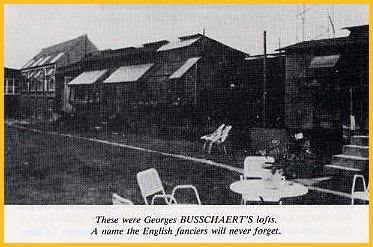

Pictures taken from pipa.be.
Belgian fanciers that do not construct their lofts in existing brick barns or in the second stories of their houses, generally build lofts in their gardens (backyards) that are designed like large chimneys. Chimneys are designed to "draft." That is, the thinner structure of chimneys is designed to draw the air through it. Loft structures in America that are wider than typical Belgian lofts, say 8' by 10', are usually too wide to draft on their own. In these cases, air movement is usually forced with fans or other type of ventilators, i.e., roof ventilators. In Belgian lofts under construction, fanciers often stand in various areas of the loft and watch the trail of smoke from a lit cigarette. If the smoke follows the right pathway from the bottom of the loft to the top, the loft is constructed properly. Consequently, the air in the loft should recharge itself on a continuous basis. Wider or deeper lofts whose interior air is relatively stagnate are not good for pigeons. Clean fresh air promotes health and vitality. Properly constructed lofts draw in fresh air on a continual basis. It is usually not advisable to open the fronts of lofts in order to create ventilation without a thoughtful consideration of the impact of the wind entering the loft from the front. Open loft fronts can be drafty and allow winds to blow directly on the pigeons. Pigeons do not fair well in drafty conditions where the wind or breeze is blowing directly on them. The nests where pigeons sit and rest in Belgian widowhood lofts usually begin about one meter off of the floor and go up to the ceiling. The windows or portals in the fronts of lofts are usually below the bottom of the lowest set of nests in the loft. The breeze entering the loft front blows below the nest boxes and usually doesn't directly affect the racers.
Proper loft construction and ventilation usually varies from geographical area to geographical area. For instance, a loft in northern Wisconsin may not be the right type of loft construction in southern Texas. Lofts should be constructed with the environmental and weather conditions of the local geography in mind. With that said, I believe that it is usually wise to construct a loft that is 6 feet or less in depth. My racing loft is such a loft. Like Belgian lofts, the air inside the loft is refreshed on a continuous basis because of the narrow construction of the loft.
In addition, the interior depth of each loft section is reduced from the exterior depth of 6 feet to approximately 5 feet because of the space of the nest boxes that occupy about a foot of space from the back wall. With my arms outstretched, I am able to physically control the air space in every direction from my body and force the racers to sit calmly and quietly in their boxes when I enter the loft. Why? Because there is nowhere for them to go to get away from me that I can't touch them, catch them and return them to their boxes. Besides creating proper ventilation, a 6 foot deep loft helps create "order" inside the loft due to the small and manageable size of each loft section.
Lofts should always be constructed in such a way that their design augments the proper management of racing pigeons.
I received a very nice email from Mo Williams. Byron and Mo were wiped out of the pigeon sport during Hurricane Katrina. However, they built a beautiful new loft and have restocked their pigeons. They purchased the first son I raised out of TOTAL RECALL and MISS BOURGES, both children of Mike Ganus's GOLDEN MATTENS. They named their pigeon HOUDINI. HOUDINI has bred excellent racers for them since his purchase. The Williams are actively involved in several pigeon-related charitable activities in their area including an educational program for children. They are the type of family that are the back bone of the sport in America and a great asset to the fancy. Mo's email is as follows:
Just thought you would like to know that "Houdini" (AU 06 TEAM 148) bred another winner! Yep, that's right. Au 08 WFL 3 won in this YB season.....1ST place vs. 506 birds 300 miles (combine) and placed 6th vs. 475b. 300 miles. Thank you for selling us such a breeding champ. May you and your family have a Merry Christmas!! Yours in the sport, Mo Williams, Williams Family Loft, Slidell, La.
Thank you Mo for the validation of the children of TOTAL RECALL and BOURGES STAR - both children of the GOLDEN MATTENS.
PHILANTHROPY
Thinking about the Williams family makes me think about philanthropy. I am always touting the pigeons and the racing system of Belgium as the best in the world. However, it has been my experience that American fanciers are far more philanthropic than the Belgian fancy. In fact, it isn't even close. Philanthropy is often and usually a significant component of the American racing pigeon sport; while in Belgium, money and personal gain are the primary driving forces. If you ever decide to visit Belgium and buy pigeons or visit pigeon fanciers, please know that your invitation will be written in Euros. Regardless of what people say, real friendships are very hard to come by in Belgium. My friendship with the Jacops family is out of the ordinary. My friendship with the Cuypers family is out of the ordinary. My friendships with many other fanciers is based entirely on money. And, no money - no friendship. It's that simple.
BUY AMERICAN
What would it take to buy American? Would European
fanciers ever buy American pigeons to the same degree that American fanciers
purchase European pigeons? Probably not. But, as a first major
step to include American racing pigeons in the same market as Belgian or
Dutch pigeons, the American pigeon racing sport must become as rigorous - or
more rigorous - as the European model. I have blogged about this point
before. I have also discussed this idea with members of our local
club. In 2009, I believe that our club will begin to take the first
steps necessary to become competitive with the Belgian racing model.
We may even tweak our model based upon certain Dutch and Asian racing
traditions, i.e., long distance and very long distance. If, for
whatever reason, the club is unable to move towards this goal in 2009, I
will do it on my own. In the next few months, I will keep you posted
on these changes. The only person I know who has tested his pigeons via the
European model is Mike Ganus. Mike does it in Holland through his
partnership there.
More to follow......................................................Thank you......................................................John and Morgan Lamberton